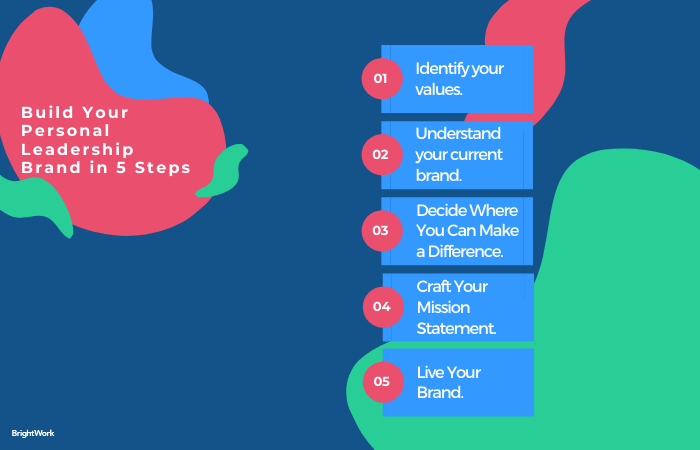Think about your most recent purchase. Did you choose a particular brand over another? Did you make this choice based on your previous experience with that brand in terms of cost, quality, consistency, ease of use? Maybe the brand fits with your lifestyle or values?
Develop your leadership skills with our free project handbook
Brand acts as a signal to consumers, and in turn, our brand choices reveal part of ourselves to those around us.
Your personal leadership brand is no different. Developing and sharing your leadership brand lets your team and colleagues know who you are, what you stand for, and how you work.
Read on to learn how to create your own personal leadership brand for project and career success.
What is Leadership?
Before you can establish your own leadership brand, you need to figure out what leadership really is and what it means to you.
Numerous definitions and styles exist, but in the context of collaborative project management, leadership is a way to excite people to outstanding performance.
A project leader uses influence – not seniority, titles, or strong personal qualities – to drive the efforts of their team towards a goal.
Leadership is critical to organizational and project success. In their book, How to Be Exceptional: Drive Leadership Success by Magnifying Your Strengths, Zenger and Folkman et al., note that organizations with exceptional leaders benefit significantly. These companies enjoy more profits, increased customer satisfaction, and higher employee retention and engagement levels.
According to the Project Management Institute’s Pulse of the Profession 2017, more organizations are prioritizing the development of leadership skills to boost project success rates. 81% of organizations surveyed for the PMI’s 2013 Navigating Complexity report cited leadership skills as paramount to project success.
Who Can Be a Project Leader?

Whilst some researchers believe leadership is an innate skill bestowed on the lucky few, experience suggests otherwise. Everyone can lead and anyone can become a great leader.
Zenger and Folkman identify 16 popular leadership qualities, which fall into five key areas, as a starting point for aspirational leaders:
- Focus on results and stretch goals.
- Initiate and lead strategic change in your organization.
- Act with honesty and integrity.
- Develop key interpersonal skills such as communication, and decision-making.
- Build your personal capability by working on relevant professional and technical skills.
They note whilst exceptional leaders have three to five outstanding strengths, developing just one area can radically enhance both individual leadership ability and benefits to the organization.
Leadership is about intent and practice. Taking time to identify, craft, and share your personal leadership brand is a critical first step to becoming a project leader.
Why do you need a Personal Leadership Brand?
Whether you realize it or not, you already have a personal brand. Your team and colleagues use what you say and do, and what you don’t say and don’t do to decide what kind of leader and person you are.
By developing your own personal leadership brand, you can control their perception, and establish direction, alignment, and commitment to agreed goals.
Unlike reputation, which is derived from past experiences and interactions, your brand is about who you are now and how you want to be seen.
Much like a commercial brand, a personal leadership brand establishes your identity and communicates your unique value to others.
Determining your leadership brand provides clarity around your goals, helping you to stay focused on the right work.
A leadership brand impacts how you behave, react, interact with others, and make decisions, influencing how effective you are in the workplace.
Your leadership brand enhances your career opportunities, demonstrating your ability and desire to take on more responsibility. Establishing your brand also makes it easier to identify what type of organization and environment will work for you.
Now that you understand the value of a personal leadership brand to project and career success, let’s look at how to create your brand.
5 Steps for Creating a Personal Leadership Brand

Developing your leadership brand requires significant investment, and a willingness to acknowledge both strengths and weaknesses. Your leadership brand is also a work in progress, changing and evolving as you move through your life and career so don’t worry about creating a final, defined vision!
Before you get started, it’s helpful to start a leadership journal or folder to document your ideas and feedback from others.
1. Identify Your Values
Values are core to our individuality and experiences. Who you are and how you treat others influences your ability to be an effective leader.
Team members will follow leaders they like, trust, and respect so what are your values? What do you stand for and what will you not stand for? What do you want to be known for? What role did your values play in key successes or failures in your life? What values do you admire in others?
When reviewing values, look for ‘hero stories’ within your organization. What traits and habits are admired in your organization? Do you currently exhibit these traits? If not, can you or should you do so? Remember – your brand must be authentic.
Trying to imitate the behavior of others to win favor is not a long-term strategy.
2. Understand Your Current Brand
Next, assess how others perceive you. Reflect on how you learn, share information, and influence others. Ask for feedback from your manager, teammates, and family regarding your communication and decision-making styles, and strengths and weaknesses.
Make note of common keywords and areas for improvement.
3. Decide Where You Can Make a Difference
Your leadership brand must clearly communicate your unique contribution to an organization or project. Think about what impact you currently have and what kind of results you wish to deliver in the next 12 months.
You should also consider who will benefit from your efforts and expertise – customers, investors, employees, and the company. This is your path to success and will help you say ‘no’ to distractions.
4. Craft Your Personal Mission Statement
At this stage, you have identified your values, figured out how other people perceive you, and set some goals for the coming year. So, how do you leverage this insight for your leadership brand?
A good place to start is a personal mission statement, which is a clear, purposeful promise to yourself, to your work colleagues, and to your family.
In addition to guiding your actions, a mission statement helps answers the big questions your team may ask – who are you, what do you stand for, and how do you work?
Stephen R. Covey introduced the concept of a personal mission statement in The 7 Habits of Highly Effective People.
In the second habit, ‘Begin with the End in Mind’, Covey argues everything is created twice; once in our imagination, as we visualize an outcome, and again when we actually achieve the goal. A personal mission statement, which draws on your values and desired end-goal, helps integrate this thinking into our lives.
Here are a few examples from CEOs across various industries to get you started:
“To have fun in (my) journey through life and learn from (my) mistakes” – Sir Richard Branson, The Virgin Group
“To live life with integrity and empathy, and be a positive force in the lives of others” – Amy Ziari, Pasta
“To be a teacher. And to be known for inspiring my students to be more than they thought they could be” – Oprah Winfrey, OWN
5. Live Your Brand
In Learning Leadership: The Five Fundamentals of Becoming an Exemplary Leader, Kouzes and Posner argue that consistency and frequency distinguish adequate and brilliant leaders, noting many individuals lead tentatively and sporadically.
Build trust in your band by living it. Share your mission statement with your colleagues so they know what to expect from you. A public commitment to your leadership brand makes it difficult for you to abandon your course at the first hurdle and creates a network of supporters.
Use your values as a compass for actions, interactions, and decisions. Ask for feedback periodically – do they see you as you imagined in your mission statement? Is your behavior consistent?
Don’t forget your online presence. If you use mediums such as LinkedIn or project management forums, your profile and interactions should be the same across all sites and tally with your daily behaviors. If you are not using these tools, now is a great time to start!
As you live your brand, make sure you take time to reflect, learn, and evolve as your goals and circumstances change. Deliberate practice and constant learning cultivate great leadership.
Conclusion
Leadership is not an innate quality, gifted to a select group. Be intentional about the kind of leader you aspire to be, commit to this goal by sharing your mission with others, and live your brand every day.
